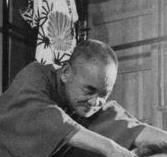Seiu Ito
Ito (伊藤) family name, Seiu (晴雨) first name, (1882-1961)
Activities
Painter, Writer, Kinbakushi
Alternate Names
伊藤晴雨(Japanese), Hajime Ito (伊藤一, real name)
Alternate Names
伊藤晴雨(Japanese), Hajime Ito (伊藤一, real name)
Summary
Born in 1882, Ito was strongly attracted to scenes of torture in stories and theater plays from an early age, and he produced a large body of paintings, drawings and photographs depicting scenes of torture and kinbaku, often using his wife or mistress as his model.
By the 1910s, Ito was a newspaper illustrator and then a theater critic. He later became the head of the Performing Arts section as well as the main illustrator for the Yomiuri News. At the beginning of the Taisho period (1912-1926), he met Kaneyo Sasaki (Oyou) and Kise Sahara, two women who would eventually become his models. He deepened his study of torture art and photography, and in the closing years of Taisho, he rode the wave of the eroguro movement and attracted attention as a “painter of perversion”. In 1928, he published his first kinbaku-related book (Seme no Kenkyu – Torment Research), which was soon after banned by the authorities.
During the Taisho period, he established theater groups whose plays centered on torture scenes. Before World War II, he published a large number of collections of graphic works through editor Suikodo Shoten. Ito was at the height of his career, but this was interrupted by the war. After the war, he worked as a writer in magazines such as Ningen Tankyu, Kitan Club and Fuzoku Soshi. In addition, he organized frequent photo sessions, and the resulting photos can be seen as “photos in the Seiyu way” in magazines such as Fuzoku Soshi, Fuzoku Kitan and Uramado. In 1953, he started the Seme no Gekidan (Torture Theater Group) which performed at Ichikawa Suzumoto theater in Tokyo and others.
He was also an historian and his lifelong research culminated in the book Iroha Biki -- Edo to Tokyo Fuzoku Yashi which details the tools and crafts of old Tokyo.
Biography
1882: Born March 3rd in Tokyo, Asakusa district, Kinryusan Kudarikawara 5, the eldest son of Kintaro Ito, a metal engraver.
1890: Accepted as an apprentice by Teiu Nozawa, a member of the Edo-based Korin school of drawing; at about nine years of age, discovers his obsession with the perfume of women’s hair as well as punishment scenes in theater plays.
1891: Receives a copy of the story of Princess Chujo from his mother. the snow torture scene in the story leaves a strong impression.
1892: Goes with his parents to the theater Honjo Kotobukiza and watches a performance of Otono Yoshida’s Maneku Furisode (An Inviting Kimono Sleeve); the scene of torture leaves a profound mark.
1894: Becomes the apprentice of ivory carver Seisyu Naito in the district of Honjo Aioi-cho, Tokyo.
1895: Starts to collect pictures related to torture.
1896: Starts to draw advertisements for theater plays.
1896: In June, Ito goes to the Haruki Theater in the district of Hongo, Tokyo to watch Nisshin Senso Youchi no Ada Tan (Raid Nocturne During the Nishiin War), a play in the Soshi Shibai (Outlaw Theater) where a scene of a nurse being tortured leaves a deep impression.
1898: While still an apprentice ivory carver, uses his free time to draw ropes of illustrations of women published in the Tokyo Asahi newspaper.
1899: Ito is strongly impressed by the torture chamber in Yoshimi Mizuno's play "Akumabarai" (Sweep Away the Demons) performed at the Tokiwa Theater in Asakusa.
1905: With the intention of becoming a painter, terminates his apprenticeship with the ivory carver and moves to Kyoto; tries different occupations in succession but eventually returns to Tokyo.
1907: Joins the Mai-Chou Shinbun as an artist/journalist for the newspaper published in the Nihonbashi, Tokyo district. He is put in charge of illustrating Ghost Island[1] by writer Syuhei Arigawa.
1909: Joins the Yamato Shinbun Sha[2] and is put in charge of illustrations.
